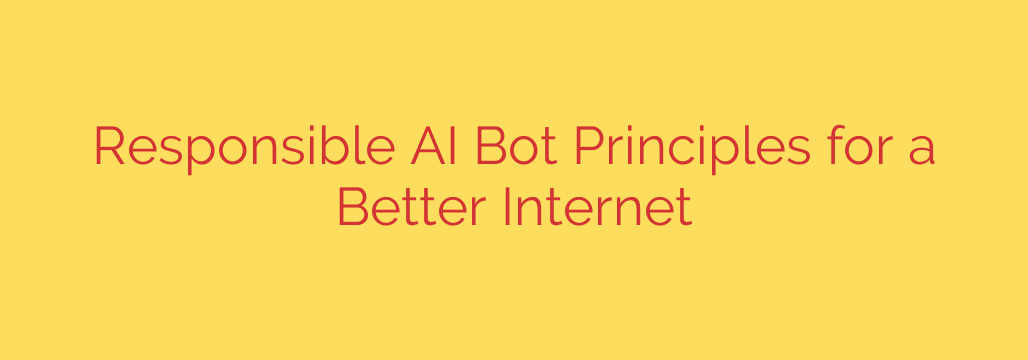
Building Trust Online: The Core Principles of Responsible AI Bots
The digital world is teeming with automated agents, or bots. From the helpful web crawlers that power our search engines to the conversational AI that assists with customer service, bots are an integral part of our online ecosystem. However, this automation brings a critical responsibility. The line between a beneficial bot and a malicious one is defined by its purpose and its principles.
For the internet to remain a safe, trustworthy, and functional space, developers and organizations must commit to a framework of responsible AI bot development. Adhering to a set of core principles isn’t just good ethics—it’s essential for building user trust and ensuring the long-term health of our digital infrastructure.
Here are the foundational principles that should guide the creation and deployment of any automated bot.
The Foundation: A Commitment to Transparency
Trust begins with honesty. Users should never have to wonder if they are interacting with a human or a bot. This principle is about eliminating deception and providing clarity at all times.
- Bots must clearly identify themselves as non-human. Whether it’s a chatbot in a customer service window or a crawler accessing a website, its automated nature should be obvious. For web crawlers, this is often done through a clear and descriptive user-agent string that allows website administrators to know who is visiting their site.
- The purpose of the bot should be clear. Users and site owners have a right to know why a bot is interacting with them or their platform. Is it indexing content for search, collecting data for research, or performing a commercial function? Hiding a bot’s intent is a hallmark of malicious activity. Full transparency is crucial to prevent deception and build confidence.
Empowering the User: Control and Respect
A responsible bot operates as a guest, not an intruder. It respects the rules of the environments it enters and acknowledges the user’s right to control their own data and experience.
- Respect established web standards. This includes honoring the
robots.txtprotocol, which gives website owners control over which parts of their site may be accessed by bots. Ignoring these directives is a significant breach of trust and online etiquette. - Provide clear opt-out mechanisms. Users should have a simple and effective way to stop interacting with a bot. For marketing or conversational bots, this means an easy-to-find “unsubscribe” or “end chat” option. Aggressive or persistent bots that ignore user requests create a negative experience and damage brand reputation.
- Operate at a reasonable pace. Bots should be designed to avoid overwhelming a website’s server. By implementing rate limiting and designing for efficiency, developers ensure their bots don’t disrupt services for human users.
Accountability by Design: Defining a Clear Purpose
Every bot should be created to serve a valuable and legitimate function. The era of launching bots without clear oversight or purpose is over. Accountability must be built into the entire lifecycle of an automated agent.
- Every bot should have a clear, beneficial purpose. Its function should contribute positively to the digital ecosystem, whether by making information more accessible, improving a service, or automating a repetitive task. Bots designed for spamming, scraping proprietary data without permission, or launching denial-of-service attacks are fundamentally irresponsible.
- Developers and organizations must take ownership. There must be a clear line of responsibility for a bot’s actions. This means maintaining contact information in a user-agent string or on a related website so that site administrators can reach out with concerns. Anonymous bots are a major red flag and are often associated with harmful activities.
Safeguarding the Ecosystem: Prioritizing Security and Integrity
Finally, a responsible bot must be a secure and stable agent that does no harm. Its design should prioritize the integrity of the systems it interacts with and the data it may handle.
- A bot must operate without compromising the stability or security of a website. This involves building bots with clean, efficient code and ensuring they don’t introduce vulnerabilities to the systems they touch.
- Protecting user data is non-negotiable. If a bot collects or processes any user information, it must do so with the highest standards of data privacy and security. This includes secure data storage, transparent privacy policies, and compliance with regulations like GDPR and CCPA. A data breach caused by a poorly secured bot can have devastating consequences.
Why Adhering to These Principles Matters
Building and deploying bots responsibly is more than a technical checklist; it’s a strategic imperative. By embracing transparency, user control, accountability, and security, we can foster a healthier, more reliable internet. For businesses, this translates directly to stronger customer trust, better brand reputation, and a more sustainable way to innovate.
Ultimately, the goal is to create a digital world where automated agents enhance human experience, not detract from it. This future is possible only when we all commit to building bots that are designed to be good citizens of the internet.
Source: https://blog.cloudflare.com/building-a-better-internet-with-responsible-ai-bot-principles/








